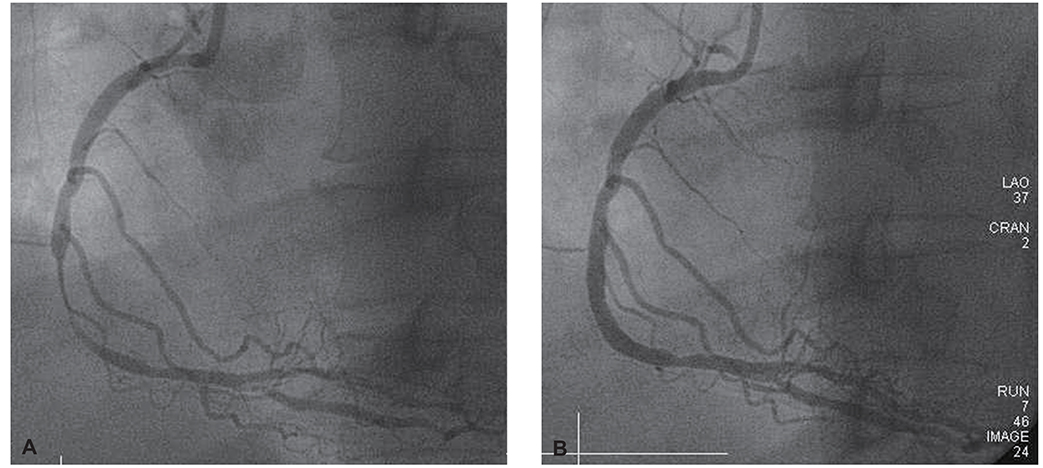Korean Circ J.
2016 Nov;46(6):870-874. 10.4070/kcj.2016.46.6.870.
Life Threatening Complication of Self-made Remedy for Controlling High Blood Pressure-Coronary Artery Vasospasm Associated with Iatrogenic Thyrotoxicosis
- Affiliations
-
- 1Department of Internal Medicine, Green hospital, Seoul, Korea.
- 2Cardiovascular Research Institute, Yonsei University College of Medicine, Seoul, Korea.
- 3Department of Internal Medicine, School of Medicine, Ewha Womans University, Seoul, Korea. pwb423@ewha.ac.kr
- KMID: 2355466
- DOI: http://doi.org/10.4070/kcj.2016.46.6.870
Abstract
- We report the case of a middle aged woman who was previously diagnosed with hypertension. She had been drinking a kelp concentrate solution daily for her hypertension instead of taking the prescribed medicine due to her personal beliefs about the kelp solution. As a consequence, she experienced vasospastic angina complicated by myocardial infarction and cardiogenic syncope resulting from iatrogenic thyrotoxicosis. Complementary medicine is widely used by the general population. However, there is still a lack of evidence regarding their efficacy and safety. This case shows that inadequate use of complementary medicine could have no effect and may even be harmful. In patients with chronic diseases such as hypertension, self-care in the form of life style modification, home blood pressure monitoring and medial adherence are important for disease management.
MeSH Terms
Figure
Reference
-
1. Chao MT, Wade C, Kronenberg F, Kalmuss D, Cushman LF. Women's reasons for complementary and alternative medicine use: racial/ethnic differences. J Altern Complement Med. 2006; 12:719–722.2. Gohar F, Greenfield SM, Beevers DG, Lip GY, Jolly K. Self-care and adherence to medication: a survey in the hypertension outpatient clinic. BMC Complement Altern Med. 2008; 8:4.3. De Geest S, Sabate E. Adherence to long-term therapies: evidence for action. Eur J Cardiovasc Nurs. 2003; 2:323.4. Ernst E. Complementary/alternative medicine for hypertension: a mini-review. Wien Med Wochenschr. 2005; 155:386–391.5. Leung AM, Braverman LE. Consequences of excess iodine. Nat Rev Endocrinol. 2014; 10:136–142.6. Eliason BC. Transient hyperthyroidism in a patient taking dietary supplements containing kelp. J Am Board Fam Pract. 1998; 11:478–480.7. Mussig K, Thamer C, Bares R, Lipp HP, Haring HU, Gallwitz B. Iodine-induced thyrotoxicosis after ingestion of kelp-containing tea. J Gen Intern Med. 2006; 21:C11–C14.8. Zava TT, Zava DT. Assessment of Japanese iodine intake based on seaweed consumption in Japan: A literature-based analysis. Thyroid Res. 2011; 4:14.9. Featherstone HJ, Stewart DK. Angina in thyrotoxicosis. Thyroid-related coronary artery spasm. Arch Intern Med. 1983; 143:554–555.10. Al Jaber J, Haque S, Noor H, Ibrahim B, Al Suwaidi J. Thyrotoxicosis and coronary artery spasm: case report and review of the literature. Angiology. 2010; 61:807–812.11. Wei JY, Genecin A, Greene HL, Achuff SC. Coronary spasm with ventricular fibrillation during thyrotoxicosis: response to attaining euthyroid state. Am J Cardiol. 1979; 43:335–339.12. Choi YH, Chung JH, Bae SW, et al. Severe coronary artery spasm can be associated with hyperthyroidism. Coron Artery Dis. 2005; 16:135–139.13. Bergeron GA, Goldsmith R, Schiller NB. Myocardial infarction, severe reversible ischemia, and shock following excess thyroid administration in a woman with normal coronary arteries. Arch Intern Med. 1988; 148:1450–1453.14. Fazio S, Palmieri EA, Lombardi G, Biondi B. Effects of thyroid hormone on the cardiovascular system. Recent Prog Horm Res. 2004; 59:31–50.15. Napoli R, Guardasole V, Angelini V, et al. Acute effects of triiodothyronine on endothelial function in human subjects. J Clin Endocrinol Metab. 2007; 92:250–254.16. Fukuyama K, Ichiki T, Takeda K, et al. Downregulation of vascular angiotensin II type 1 receptor by thyroid hormone. Hypertension. 2003; 41:598–603.17. Napoli R, Biondi B, Guardasole V, et al. Impact of hyperthyroidism and its correction on vascular reactivity in humans. Circulation. 2001; 104:3076–3080.18. Hermenegildo C, Medina P, Peiro M, et al. Plasma concentration of asymmetric dimethylarginine, an endogenous inhibitor of nitric oxide synthase, is elevated in hyperthyroid patients. J Clin Endocrinol Metab. 2002; 87:5636–5640.19. Finset A, Gerin W. How can we promote medication adherence and lifestyle changes in hypertensive patients? Patient Educ Couns. 2008; 72:1–2.20. Bell RA, Kravitz RL. Physician counseling for hypertension: What do doctors really do? Patient Educ Couns. 2008; 72:115–121.
- Full Text Links
- Actions
-
Cited
- CITED
-
- Close
- Share
- Similar articles
-
- Clinical Characteristics of Thyrotoxicosis Presented by Coronary Spasm
- Coronary Artery Vasospasm with Acute Myocarditis in an Adolescent
- Proximal Coronary Artery Stenosis after Direct Coronary Artery Ostial Perfusion : Report of 3 Cases
- Native Coronary Artery and Grafted Artery Spasm Just after Coronary Artery Bypass Grafting: A Case Report
- Coronary Artery Vasospasm





